Homeland (video game)
| Homeland | |
|---|---|
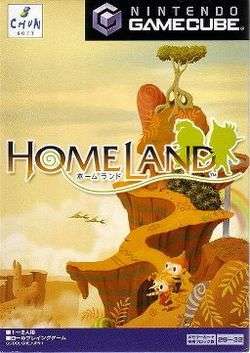 Cover art | |
| Developer(s) | Chunsoft |
| Publisher(s) | Chunsoft |
| Composer(s) | Hayato Matsuo |
| Platform(s) | GameCube |
| Release date(s) |
|
| Genre(s) | Role-playing video game |
| Mode(s) | Single-player, multiplayer |
Homeland (ホームランド hōmurando) is a role-playing video game for the Nintendo GameCube developed and published by Chunsoft, and was released in Japan on April 29, 2005.
The game can be played offline in single-player mode or online in multiplayer mode over the internet or on a LAN. In online mode the player can assume the role of gamemaster and create an online game for up to thirty-five other players.[1] It is one of only four titles for the GameCube designed for online play. It is unique among these games in a number of ways. It is the only one where the GameCube itself acts as the server, rather than the player using a central server. It is also the only online GameCube game that isn't a Phantasy Star Online title, and the only one not to get a release outside Japan. Images of the game can be seen on the official HOMELAND website (in Japanese).
Gameplay
HOMELAND features nonlinear gameplay with branching storylines and multiple endings, and (especially in multiplayer mode) co‑operative gameplay.
The player begins by choosing his or her avatar (a boy or a girl) and giving it a name. Next there is an introductory sequence of events in which the player answers a few questions that will determine which two "mascots" the player will have from the start. A mascot is a sort of avatar that the player's avatar transforms into before setting off on an adventure. Each mascot has different attributes and skills, and more mascots can be acquired in subsequent adventures through the accumulation of "clear points" for clearing certain events. In one storyline however, the player does not select a mascot but enters the adventure world as the original avatar, named Bibi (ビビ) for the girl and Hal (ハル) for the boy.
Players begin each new adventure at level 1 and level up as they acquire experience points. A distinctive feature of HOMELAND is the ability of players to join hands and form a chain in order to combine their stats and special attributes. Communication is displayed as voice bubbles coming from the player characters (PC) and from the non-player characters (NPC). In weakened characters the background color of the voice bubbles changes from white to yellow and eventually to red when they are almost defeated. Distant voices appear as smaller voice bubbles near the edge of the screen. Players can be equipped with weapons, shields and accessories, and can carry a very limited number of items.
Co-operative play
Players in a multiplayer game do not normally battle each other; instead they benefit by helping each other to battle enemies and achieve common objectives. Some storylines cannot be completed without coordinated actions by a number of players. When players join hands to form a chain the lead player in the chain is in control and is the only one able to attack or to receive damage. This tactic provides a useful way of quickly levelling up a player who has just entered the game, and may be essential in a storyline where a particular attribute is needed to provide an immunity and not all of the players have that attribute. It is also possible to use the chain as a shield in order to prevent the leader having to battle too many monsters at once (a form of crowd control). Each member of the chain can "unjoin" at any time and continue independently.
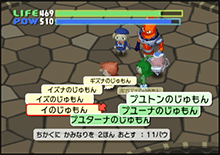
In an offline game the player can summon their other mascots to come and assist them as though they were other players. These mascots become their companions and are controlled very effectively by the game's AI. The companions will follow the player around and assist in battles by fighting and – depending on their skills – by restoring the player's health. Companions can be equipped with weapons, shields and accessories, but cannot carry items. When a player logs out of a multiplayer game (or is absent too long) their mascot remains in the game as a companion and automatically "gives" any key items that it may be carrying. If the player rejoins the game they automatically regain control of their mascot.
Ring menus and spiral menus
Short menus are displayed as a ring of options around a pointer controlled with the joystick. An option can be selected sequentially by rotating the pointer like the hands of a clock, or directly by moving the joystick in the direction of the option. Longer menus are displayed as a ring of options that appear and disappear progressively as the pointer is rotated around the ring. This is compared visually to moving through the center of a spiral from one end to the other.
Communication
Players communicate in a multiplayer game via text messages entered using the game controller and a menu-like visual keyboard (keyboard controllers are not supported).[2] This method is very slow at first, but becomes more efficient as the game remembers words and proposes them in a way similar to predictive text on a mobile phone. Messages entered in this way appear in the avatar's voice bubbles and are visible to all nearby players. There is also a way of broadcasting a message to all players anywhere in the game using a "shout" command. Emotional states of characters are displayed in anime or manga style, and can expressed by the player by selecting the corresponding emotion from a ring menu. Possible states are: laughing, shocked, surprised, sad, angry, embarrassed, puzzled, and panicked. The effect lasts for just a second or two.
Quester Park
Hovering above the clouds is a transportation and communication hub called Quester Park. It is the starting point for new adventures and provides a convenient way of travelling from one region to another later in the game. It is divided into two areas with facilities staffed by helpful "angels".
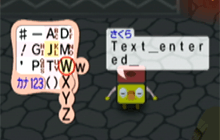
Information desk and bell
One of the most important facilities is the bell next to the information desk at the front of the park. In a single-player, offline game the bell can be used to summon the player's other mascots to join the player as members of a group. A fee must be paid which is quite small for the first mascot, but which increases very rapidly for each additional mascot. In a multiplayer game the bell is used to locate and communicate with other players.
Communication practice
Instructions and advice on how to communicate with other players are provided by the angel Timote (ティモテ). A fast-talking minigame gives the player practice in using the interface and an opportunity to earn some experience points at the same time.
Ramps
The second area of Quester Park is ringed with ramps that can be used to transport the player to the "altars" found in each town and village. A ramp cannot be used until the location of the corresponding altar has already been visited once on foot.
Key items storage
Key items that are not needed but cannot be discarded can be left with the angel Kamonau (カモナウ) and picked up later. This frees up needed space in the player's inventory for other items. Key items may be left here when a player logs out.
Items
Items used in the game are usually bought in shops and from stallholders, but they are also obtained as loot by defeating an opponent and found lying around in treasure chests. They are grouped into the following categories:
- Weapons
The player starts with simple items such as sticks and clubs and gradually progresses to more powerful and expensive weapons such as swords that may affect the player's stats. - Shields
May be as simple as a piece of leather or scrap iron, or proper shields giving much more protection and modifying the player's stats. - Accessories
Decorative items such as badges, pendants and medals that increase some of the player's stats and may lower others. - Tools
These are mainly items used for recovery or escape, but also include "drops" that can be sold for a lot of money. - Valuables
These are key items that are needed to progress in an adventure. They are usually obtained by defeating a boss or by helping an NPC.
Storylines
Depending partly on the sequence of key events that are initiated by the hero, an adventure may follow one of a number of possible storylines. Other factors that may have an influence are the number of participating players and, in one case at least, whether or not a particular adventure has already been "cleared". Each adventure begins in the quester's room and ends with a meeting with the "big god", who congratulates the heroes and heroines and hands out some rewards. After this the adventurer is returned to their room to begin again at level 1 but having acquired some "clear points" with which to buy additional mascots and accessories that can be used to personalise the mascots. Possible storylines are:
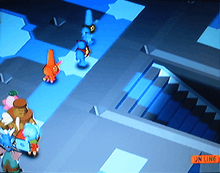
- Boron Parts (ボローンパーツ boronpatsu)
Morubon is trapped in an underground cave. Rescue him and then help him find the four "Boron Parts" that he was looking for. This is an online-only adventure. - Dark World (暗闇の世界 kurayami no sekai)
When the quester tries to rescue a lost ghost some evil spirits try to prevent it from leaving; they scatter parts of the ghost's soul and curse the world to be covered in darkness. The quester must now recover all six pieces of the ghost's soul and remove the curse with the help of a mysterious flower encountered along the way. - Demon King (魔王 maou)
The king of the demons was defeated 100 years ago - has he returned? - The Demons (魔族 mazoku)
An online, multiplayer adventure in which some of the questers are cursed and try to catch the others. Three or more players are needed. - Dream World (ユメの世界 yume no sekai)
When all the inhabitants of the homeland are put to sleep by the demon king, the quester has to enter the world of dreams to awaken them. This storyline is notable for the giant flying "whale" (actually like a cross between a whale, a catfish and a coelacanth) and a maze on a rotating cube. Finding out how to summon the whale is the biggest challenge in this adventure. - The Golems (ゴーレム gouremu)
The golems (artificial creatures) feel they have been mistreated by their masters the robot people so they rebel. - Jailbreak (脱獄 datsugoku)
An online, multiplayer adventure in which the questers are imprisoned by the robot people and must try to escape. Four players are needed, and cooperation and co-ordination are essential. - Jintori (陣取り jintori)
An online, multiplayer adventure that requires at least ten players. A festival takes place in which one of the events is a game of jintori. Players are divided into five teams identified by animal symbols (crab, bear, rabbit, tiger and frog) that compete to capture thirteen bases. - Micro (ミクロ mikuro)
Instead of defeating a final boss, players participate in a quiz about HOMELAND. Some questions must be answered within a time limit making this one of the hardest adventures to clear. It is called Micro because the players' mascots are shrunk so that they can enter a toy maze near the end. - Oragon (オラゴン oragon)
This is the shortest and easiest adventure: defeat the dragon "Oragon" and recover the important item that he stole. - Parasquid (パラダイカ paradaika)
The king of the squid people lost his memory when his spaceship crashed on the homeland and he has been imprisoned for a crime he did not commit. Free the king by finding the true culprit and then restore him to his throne which has since been seized by a usurper. - The Tale of the Hero and the Demon King (魔王と勇者の物語 maou to yūsha no monogatari)
This is an offline only adventure which does not require the quester to transform into a mascot - instead it begins in the "real" world. The player must go back in time 100 years and help save the world from being consumed by darkness. There many puzzles and mysteries to solve, making this one of the longest and most interesting adventures. It is unlocked by clearing the Demon King adventure; the angel in the closet then transforms the homework on the table into a book, and reading this starts the adventure.
Gamemaster
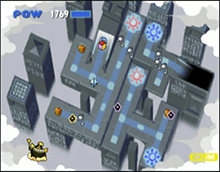
The gamemaster begins a new game by selecting the "god" mascot and setting up the game parameters. During the game the gamemaster sees a map of the entire homeland and can "descend" to locations where there are players. The gamemaster cannot descend to a location in the game in which there is currently no player mascot present. The gamemaster sees a broader area than the individual players do, as though looking down through the clouds. Players and monsters are represented as moving icons and their voice bubbles are visible. The gamemaster's icon is controlled like a cursor and when placed over a player icon the name of the player is displayed. If left on a player icon, the cursor will automatically follow the icon as the player moves. The gamemaster can see a name list of all the players in the game, and can "jump" to the location of a selected player.
Powers
The gamemaster has no need of health points but does acquire power points as the players progress in the game. Power points are needed to perform "miracles" (similar to skills) such as causing monsters or items to suddenly appear. In this way the gamemaster is able to influence the game by helping or hindering the players. Miracles are unlocked and bought in a similar way to mascots and accessories. The gamemaster also has the ability, if necessary, to "evict" a troublesome player from the game. Players can send a message to the gamemaster and pay to increase the gamemaster's power points using the "god" telephones found in towns and villages.
Suspending the game
The gamemaster can suspend and save the game at any time and then resume from the saved state later; it is not necessary to keep the console switched on all the time. Furthermore, the state of the game is saved automatically every few minutes to the Memory Card in the game server console so it will not be lost if there is a power failure.
Online mode configuration
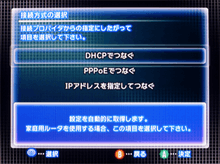
A Nintendo GameCube Broadband Adapter (DOL-015) is required for multiplayer mode on the internet. The GameCube Modem Adapter (DOL-012) is not supported.[2] The online option does not become available until the first adventure has been completed offline.[2] This ensures that the player has learned how to play before participating in a multiplayer game.
The network connection settings are configured in the game and saved in a Network Settings file on a Memory Card in Slot A. The file must be saved on the same Memory Card as the HOMELAND game save file.[3] Although the Network Settings dialog is accessed from within the game it looks like a separate application - it has a completely different visual style and uses kanji text while the game uses only kana.
Settings
The following types of connection are supported:
- DHCP connection (automatic and manual configuration)
- PPPoE connection (automatic and manual configuration)
- Static IP address
A typical configuration on a home network would be DHCP with automatic assignment of the network parameters. Manual DHCP configuration requires the primary and secondary DNS server address to be entered. A PPPoE connection requires in addition to this the internet service user ID and password, and whether or not to save the password. A static IP address connection requires the IP address, subnet mask, default router, primary and secondary DNS server address to be entered. The network connection can be tested from a menu option before going online; error code [21003] indicates a successful connection.
An additional requirement since the end of the official matching server is to change the connection method so that instead of connecting automatically to the matching server the player is prompted to enter the IP address of the destination GameCube that is acting as a game server. This is done in the game by saying #switch connection (せつぞくきりかえ) to the "angel" NPC that appears from the closet in the quester's room. This only has to be done once as the change is saved to the Memory Card. This change also makes it possible to play a multiplayer game on a LAN.
For other players to be able to connect to the gamemaster's GameCube over the internet it must be accessible through port 9003 on a global IP address.[4] The gamemaster should ensure that the IP address remains fixed for the duration of the game, otherwise players will be disconnected and must be informed of the new IP address before they can continue.
Beta test
A beta test version of the game was produced which can be recognised by the simple monochrome packaging and user guide. The disc and packaging are labelled "Not for sale" and "TEST DISC" (in Japanese), which also appears on the title screen. A disclaimer is displayed when the game is loaded.
CHUNSOFT gave away 1,000 copies of the beta test version as prizes in a competition[5] shortly before the release of the game in 2005. Winners were selected randomly from customers who preordered the game between 10 and 25 February. These "free trial versions" enabled players to try out the opening stage of the game only; the first adventure ends when the player reaches the next region in the game. Those who had ordered the Broadband Adapter bundle received their copies in time for beta testing of the network (from 15 to 27 March)[6] making it possible for them to try out the multiplayer Internet Adventure mode too.
Games saved in the test version cannot be loaded in the full version of the game.[2]
References
External links
- Official website (in Japanese)